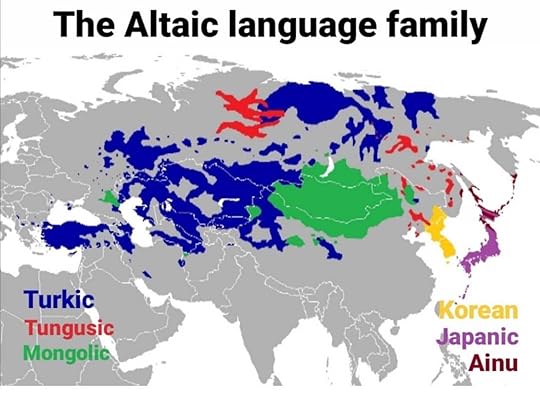Languages of the Silk Road and Beyond

Episode 14 Languages of the Silk Road and Beyond
Language Families of the World
Dr John McWhorter
Film Review
Regions involved in the ancient Silk Road trade developed their own discrete languages belonging to the Altaic family (with Turkic, Mongolian and Tungasic being the main subfamilies). At some point, all three have been the official languages (employing Chinese script) of China.
All Altaic languages put the verb at the end of sentences and use suffixes more commonly than prefixes.
Genghis Khan used Turkic languages in the countries he conquered and ruled.
The Turkic language began in Mongolia and spread east and west with the Mongolian conquests. The Huns spoke Turkic, and the Mughals who conquered India spoke Turkic in preference to Persian.
The people of the Anatolian peninsula initially spoke Hittite, then Greek, then Seljik Turkic, then Ottoman Turkish. Turkic has many different dialects that shade into one another, with even more word similarities than the Romance languages.
Sekiz, the Turish word for 8 is
səkkis in Azerbaijanisekis in Turkmansakkis in Uzbeksegrz in Kazaksäkkiz in UighurAltaic languages incorporate “vowel harmony” which means the vowel suffix for plurals changes depending on where the main vowel is formed in in the mouth. They also have “suffix sandwiches,” in which suffixes are combined to make a sentence out of a single long word.
They also have many loan words from Persian and Arabic. For example Altaic speakers often use Persian expressions in complex academic writing (eg mathematical principles).
In 1920, the founder of modern Turkey Kemal Ataturk took steps to solidify Turkey’s Western identity by switching Turkish script from the Arabic to the Roman alphabet and by purging Turkish (and substituting Turkish of all its Arabic and Persian words.
Mongolian – Mongolian didn’t spread beyond the homeland despite all the Mongol conquests because Genghis Khan and his successors used Turkic languages to rule the territories they conquered.
Kalmyk – Turkic language spoken in Russia. Ewak, the invented language used in Return of the Jedi is based on Kalmyk. Has verb variations for hypothetical actions similar to the Indo-European subjunctive.Tungasic languages – found in small scattered groups in Eastern China and Siberia. Manchu, the language of China’s ruling elite* for 300 years (until 1912) is a Tungasic language. Three hundred thousand residents of Xinjiang province still speak Manchu as a result of a Manchu garrison stationed there.*Rather than requiring their Chinese subjects to learn Manchu, the Manchu dynasty made extensive use of interpreters.
Film can be viewed free with a library card on Kanopy.
https://www.kanopy.com/en/pukeariki/watch/video/6120000/6120030
The Most Revolutionary Act
- Stuart Jeanne Bramhall's profile
- 11 followers



